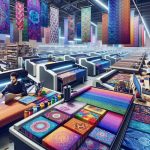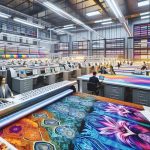Looking for the latest advancements in the textile industry? Discover what’s new and exciting in textile industry innovations.
From advanced materials to sustainable production practices, you’ll find cutting-edge developments that are revolutionizing the way fabrics are made.
Dive into the world of smart textiles and explore the possibilities of digital printing.
Learn about the circular economy and how it’s transforming the way we think about fashion.
Get ready to be inspired by the future of textiles.
Table of Contents
Advanced Materials
You’ll be amazed by the wide range of advanced materials revolutionizing the textile industry. One of the most exciting innovations is the use of 3D printing technology. With 3D printing, intricate and complex designs can be created with ease, allowing for unique and personalized textiles. This technology has opened up a world of possibilities, from creating custom-fit garments to producing intricate patterns and textures.
Another groundbreaking advancement in the textile industry is the integration of nanotechnology. Nanotechnology involves manipulating materials at the nanoscale, allowing for precise control over their properties and performance. Nanomaterials can be incorporated into textiles to enhance their functionality and durability. For example, nanoparticles can be added to fabrics to make them stain-resistant or waterproof. Nanofibers can also be used to create textiles with enhanced strength and flexibility.
The combination of 3D printing and nanotechnology has led to even more exciting developments. Researchers are now exploring the use of 3D printing to create nanoscale structures within textiles, opening up possibilities for creating fabrics with unique properties and functionalities. This could revolutionize the textile industry by allowing for the production of smart textiles that can sense and respond to their environment.
Sustainable Production
To continue the discussion from the previous subtopic on advanced materials, let’s now explore the exciting advancements in sustainable production within the textile industry. As the world becomes increasingly conscious of the environmental impact of manufacturing processes, eco-friendly manufacturing practices have gained significant attention. In the textile industry, sustainable production involves implementing strategies that minimize harm to the environment while still meeting consumer demands for quality and affordability.
One key aspect of sustainable production is the use of renewable fibers. These fibers are derived from natural sources that can be replenished, such as organic cotton, hemp, and bamboo. By utilizing renewable fibers, textile manufacturers can reduce their reliance on non-renewable resources like petroleum-based synthetic fibers, which have a detrimental impact on the environment.
To give you a clearer picture, here’s a table showcasing some examples of renewable fibers used in eco-friendly manufacturing:
| Fiber | Source |
|---|---|
| Organic Cotton | Cotton plants |
| Hemp | Hemp plants |
| Bamboo | Bamboo plants |
Smart Textiles
Now let’s explore the advancements in smart textiles, which have emerged as a game-changer in the textile industry. These interactive fabrics have revolutionized the way we think about clothing and opened up exciting possibilities for wearable technology.
Here are four key aspects to consider:
-
Embedded Sensors: Smart textiles are now equipped with sensors that can detect and measure various parameters such as temperature, heart rate, and movement. These sensors provide valuable data for monitoring health and performance.
-
Connectivity: With the integration of wireless technology, smart textiles can connect to smartphones and other devices, allowing for seamless communication and data transfer. This connectivity enhances the functionality and versatility of wearable technology.
-
Adaptive Clothing: Smart textiles have the ability to adapt to changing environmental conditions. For example, they can adjust their insulation properties based on temperature or regulate moisture to keep the wearer comfortable in different situations.
-
Interactive Design: Smart textiles enable interactive experiences through touch-sensitive fabrics, allowing users to control devices or access information by simply touching their clothing. This intuitive interaction enhances user experience and convenience.
The advancements in smart textiles have paved the way for innovative applications in various sectors, including healthcare, sports, and fashion. As technology continues to evolve, we can expect even more exciting developments in the field of wearable technology.
Digital Printing
Moving on to the next innovation in the textile industry, let’s explore the advancements in digital printing. Digital printing techniques have revolutionized the way textiles are designed and produced. With the use of computer-controlled printers, intricate patterns and designs can now be printed directly onto fabric with precision and speed.
One of the key benefits of digital printing is its ability to automate the textile industry. Traditional printing methods required multiple steps and manual labor, which were time-consuming and costly. Digital printing eliminates the need for screens and plates, reducing setup time and increasing efficiency. This automation also allows for greater customization and flexibility in design, as patterns can be easily modified and reproduced.
Moreover, digital printing offers a wider range of color options and finer details, resulting in high-quality prints. It also allows for the use of multiple colors and gradients, giving designers more creative freedom. Additionally, digital printing reduces waste and environmental impact, as it requires fewer chemicals and resources compared to traditional printing methods.
Circular Economy
The circular economy is a sustainable approach that aims to minimize waste and maximize resource efficiency in the textile industry. This concept focuses on creating a closed-loop system where products are designed to be recycled, repurposed, or upcycled, rather than being disposed of as waste. By implementing circular economy principles, the textile industry can significantly reduce its environmental impact and contribute to a more sustainable future.
Here are four key ways in which the circular economy is transforming the textile industry:
-
Upcycling textiles: Rather than discarding textile waste, upcycling involves transforming it into new and improved products. This process not only reduces the amount of waste generated but also creates value from materials that would have otherwise been lost.
-
Waste reduction: The circular economy emphasizes reducing waste throughout the entire textile supply chain. By adopting strategies such as lean manufacturing and waste tracking systems, companies can identify areas of waste generation and implement measures to minimize it.
-
Extended product lifespan: The circular economy encourages the development of products that are durable and long-lasting. By creating high-quality textiles that can withstand multiple uses, the need for frequent replacements is reduced, leading to a significant reduction in waste.
-
Closed-loop recycling: In a circular economy, textiles are recycled into new fibers or materials, creating a closed-loop system. This process not only reduces the demand for virgin materials but also reduces the environmental impact associated with the production of new textiles.
Frequently Asked Questions
How Many Different Types of Advanced Materials Are Currently Being Used in the Textile Industry?
There are several different types of advanced materials being used in the textile industry. These materials are designed to enhance performance, durability, and sustainability in the production process.
What Are Some Examples of Sustainable Production Practices Being Implemented in the Textile Industry?
When it comes to sustainable manufacturing in the textile industry, there are many eco-friendly practices being implemented. For example, companies are using recycled materials, reducing water usage, and implementing renewable energy sources.
How Do Smart Textiles Differ From Traditional Textiles in Terms of Functionality?
Smart textiles differ from traditional textiles in terms of functionality by incorporating advanced technology like sensors and actuators. They have applications in healthcare and sports industries, and can be integrated with IoT technology for improved performance.
What Are the Advantages of Digital Printing Over Traditional Printing Methods in the Textile Industry?
Digital printing offers several advantages over traditional printing methods in the textile industry. With digital printing, you can achieve more vibrant colors, intricate designs, and faster production times, making it a cost-effective and versatile choice for textile manufacturers.
How Does the Circular Economy Concept Apply to the Textile Industry and What Initiatives Are Being Taken to Promote It?
Circular economy initiatives in the textile industry promote sustainable production practices. By implementing recycling and upcycling methods, companies reduce waste and conserve resources. These efforts contribute to a more environmentally friendly and economically viable industry.
- How Trade Policies Affect Fabrics - July 18, 2024
- Economic Impact of Sustainable Textiles - July 18, 2024
- Global Trends in Fabric Economics - July 18, 2024




